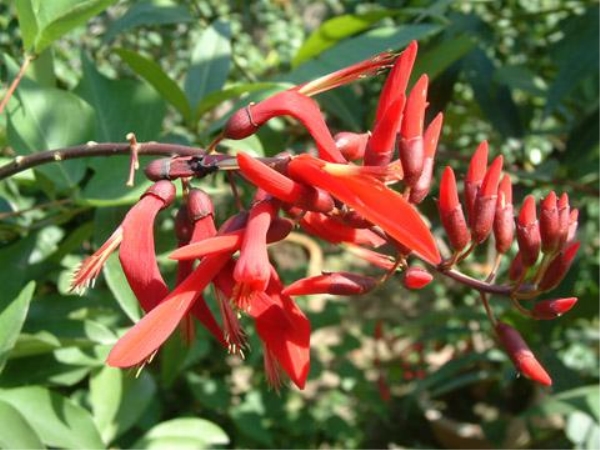Problems needing attention in breeding Longya Flower
Avoid excessive contact
The dragon tooth flower is colorful and very suitable for breeding as an ornamental flower, but because it is poisonous. Therefore, in the process of breeding, care should be taken to avoid excessive contact, do not touch its juice, and do not put it in a place that is easily accessible to children.

Do not "take stomach"
Although the dragon tooth flower is poisonous. But its flower smell is non-toxic, so as long as we do not have excessive contact, put it on the windowsill or balcony as a potted plant to watch, can only watch, do not swallow it as food.
The dragon tooth flower has a high appreciation value when it is in bloom, we can only watch it, do not eat it! As long as we do not pick and eat by mistake, its toxicity will do no harm to us!
Matters needing attention in breeding Longya Flower
Longya flower is easy to encounter diseases and insect pests in the process of growth. the common diseases are root rot, Fusarium wilt and anthrax, and the main pests are aphids and shell insects. Diseases can be treated by spraying Bordeaux liquid and other insecticides, and pests can be killed by pesticides or more environmentally friendly home-made pesticides.
Although the dragon tooth flower has a higher appreciation value, but in the process of breeding, we should also remember that the dragon tooth flower is more toxic, do not eat the dragon tooth flower!
Culture methods and matters needing attention of Longya flower
Selection of potted soil for the Culture of Longya Flower
Longya flower is a large woody flower, potted plants need to choose a larger flowerpot, the soil needs to choose well drained, fertile, loose sandy loam, the fertility requirement is not high, but can not be too barren, too barren or too dry soil, Longya flower will grow poorly.
Light and temperature
The dragon tooth flower likes the growth environment with sufficient light, can withstand the semi-overcast, and it is best to give about 5 hours of light every day. It likes a warm climate, can withstand high temperature, and has poor cold resistance. The suitable temperature for the growth of Longya flower is between 20 ℃ and 28 ℃. It needs to be kept warm in winter. If there are conditions, it can be exposed to a greenhouse to spend the winter.
Watering and fertilizing
Longya flowers like the humid environment, but should not be waterlogged, watering should be appropriate, in summer high temperature and drought to increase watering, keep the basin soil moist, if necessary, can spray water to the leaves; the winter temperature is low, watering should be reduced, especially after putting into the greenhouse. If you apply fertilizer, you can apply fertilizer once every half a month during the growth period, and phosphorus and potassium fertilizer once or twice during flowering. After the beginning of autumn, we need to stop fertilizing.
Matters needing attention in the Culture of Longya Flower changing pots
Longya flower when a large plant, with the need for growth to change the basin, generally every 2 to 3 years to change the basin, in the spring, can be combined with the basin for pruning.
Pruning
Longya flower can be pruned in spring, cutting off withered branches and long branches to form more flower branches. Winter can also be pruned for better winter.
Diseases and insect pests
The common diseases of Longya flower are root rot, Fusarium wilt and anthracnose, and the main pests are aphids and shell insects. Diseases can be treated by spraying Bordeaux liquid and other insecticides, and pests can be killed by pesticides or more environmentally friendly home-made pesticides.
- Prev

The reproduction of apple grandma
Sowing and reproduction this is one of the easiest methods of reproduction, but it takes some time to mature. First of all, when the apple woman is ripe, pay attention to the maintenance of the seeds. Before sowing, do not expose to the sun, keep moist, treat the soil first, then pick it, and finally sow the seeds into the soil.
- Next

Matters needing attention in daily maintenance of Bauhinia
First, the soil loose drainage good acid sandy soil, the soil can be fertile and barren, because it is resistant to barren. When transplanting Bauhinia, it is appropriate to bring some soil to the root of Bauhinia, which can improve the survival rate of transplantation. Second, light and temperature Bauhinia prefers a sunny and warm environment, because Bauhinia is not very hardy
Related
- Fuxing push coffee new agricultural production and marketing class: lack of small-scale processing plants
- Jujube rice field leisure farm deep ploughing Yilan for five years to create a space for organic food and play
- Nongyu Farm-A trial of organic papaya for brave women with advanced technology
- Four points for attention in the prevention and control of diseases and insect pests of edible fungi
- How to add nutrient solution to Edible Fungi
- Is there any good way to control edible fungus mites?
- Open Inoculation Technology of Edible Fungi
- Is there any clever way to use fertilizer for edible fungus in winter?
- What agents are used to kill the pathogens of edible fungi in the mushroom shed?
- Rapid drying of Edible Fungi

